Items filtered by date: December 2024
Benefits of Using Walking Sticks
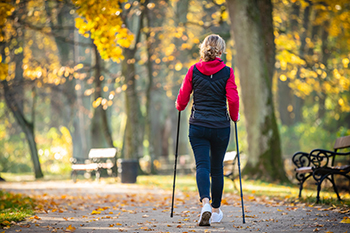
Walking sticks, also known as trekking poles, can significantly enhance the walking experience for people of all ages and abilities. These poles provide additional stability, making it easier to navigate uneven terrain and reducing the risk of falls. By redistributing weight, walking sticks decrease strain on the lower body, especially the knees, hips, and ankles, which can benefit those with joint pain or limited mobility. Additionally, they support proper posture and balance, encouraging a more confident stride. Using walking sticks can also boost cardiovascular activity, as they engage the upper body during movement, making walking a more effective form of exercise. A chiropodist can guide you in selecting and adjusting walking sticks to suit your height, walking style, and specific needs, ensuring they provide optimal support. Proper usage techniques, such as the pole length and a relaxed grip, are also important to maximize their benefits. If you experience foot or ankle pain while walking for exercise, it is suggested that you schedule an appointment with a chiropodist for guidance.
Stretching and strengthening your feet is very important for maintaining your foot health. If you would like to learn more about exercises for your feet, please consult with Emily Yu, B.Sc from Uptown Foot Care Clinic. Our specialist can help you maintain the health of your lower limbs and your mobility.
There are a variety of relatively easy-to-do exercises that can boost the strength, flexibility, and mobility of your feet, as well as relieve foot pain.
Strength exercises:
Toe splay - Spread the toes apart and hold for several seconds; improves control over toe muscles
Toe curls - Scrunch up a towel with your toes; strengthens the flexor muscles
Marble pickup - Pick up marbles with your toes; strengthens the muscles on the undersides of the feet and toes
Walking on sand - Stretches and strengthens feet and calves
Flexibility exercises:
Heel raises - Raise the heels while keeping toes on the ground
Toe point - Raise the heels while pointing the toes, keeping just the tips of toes on the ground
Toe curl - Raise the heels while curling the toes inwards, keeping just the tips of toes on the ground
Big toe stretch - Use your hands to gently stretch your big toes up, down, and to the side
Exercises for foot pain:
Toe extension - Gently pull the toes up towards the ankle and hold for several seconds
Ball roll - gently roll a golf or tennis ball underneath the arches of the feet
If you have any questions, please feel free to contact our office located in . We offer the newest diagnostic and treatment technologies for all your foot care needs.
Why Older People Fall and How It Affects the Feet
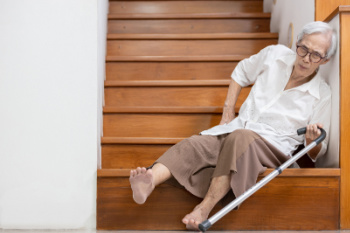
Falls are a common concern for older adults, often resulting from reduced muscle strength, poor balance, and declining vision. As people age, the muscles and ligaments that support the feet weaken, leading to decreased stability and a higher risk of tripping or losing balance. Foot problems such as arthritis, bunions, or neuropathy can also contribute to falls. When older adults fall, it can lead to injuries like sprained ankles, broken bones, or foot fractures which may further limit their ability to walk or maintain independence. Proper footwear, regular exercise to improve balance and strength, and foot care are vital in preventing falls and reducing their impact. If you are elderly and have endured a fall that has injured your feet, it is suggested that you consult a chiropodist who can provide treatment and guide you on effective fall prevention techniques.
Falls are a major cause of injury among the elderly. To learn more about preventing falls or to get treatment following a foot or ankle injury caused by a fall, please consult with Emily Yu, B.Sc from Uptown Foot Care Clinic. Our specialist will assess your condition and provide you with quality foot and ankle treatment.
Falling is one of the leading causes of injury among the elderly. It is said that about 50% of falls that result in hospitalization occur in the home. Fortunately, there are steps that you can implement to reduce your risk of falling in the home.
Tips to Prevent Falls at Home:
In the bathroom - Place non-slip mats in the shower or tub, install grab bars near the toilet and bath, and wipe up any moisture or spills as soon as possible.
In the living rooms and bedroom - Remove loose wires, cords, or other objects that may be an obstacle to moving around safely. Make sure that you have good lighting throughout the home so that you can always see where you are going. Get rid of any rugs or mats that are not firmly anchored or that may cause you to trip. When walking around the home, move slowly.
In the kitchen - Store food and supplies in easily accessible areas, store heavy items in lower cupboards, and wipe up any spills immediately to prevent slipping.
On the stairs - Make sure that the stairs are well-lit and have secure handrails. Walk slowly when ascending or descending the stairs.
Outside - Keep walkways well-lit and clear of snow, ice, leaves, and man-made tripping hazards.
Maintaining your overall health, including the health of your feet, can also help to prevent falls. Eat a healthy diet, exercise regularly, and wear well-fitted, comfortable, and supportive shoes. If you have a mobility device, such as a cane, use it while walking.
If you have any questions, please feel free to contact our office located in . We offer the newest diagnostic and treatment technologies for all your foot care needs.
Impact of Flat Feet
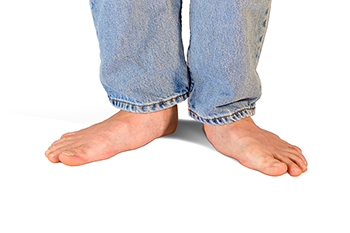
Flat feet, also known as fallen arches, is a condition where the arches of the feet are lower than normal or completely absent, causing the soles to touch the ground when standing. Flexible flat feet is a condition in which the arch disappears while standing, but reappears when sitting. Rigid flat feet remain flat regardless of position. The causes of flat feet can include genetic factors, injury, or conditions like arthritis. Symptoms may vary but often include pain or discomfort in the feet, particularly in the arches or heels. People with flat feet may also experience swelling or fatigue in their legs, making walking or standing for long periods difficult. In some cases, flat feet can lead to issues in other parts of the body, such as the knees, hips, and lower back, due to improper alignment. If you have flat feet, it is suggested that you are under the care of a chiropodist who can offer relief and management tips.
Flat feet are a common foot condition. If you are experiencing pain or discomfort due to flat feet, please consult with Emily Yu, B.Sc from Uptown Foot Care Clinic. Our specialist will assess your condition and provide you with quality foot and ankle treatment.
What Are Flat Feet?
Flat feet are feet that do not have a well-defined arch in the middle of the sole of the foot. Flat feet may be flexible or rigid. Flexible flat feet have an arch when there is no pressure put on the foot, such as when one is sitting, but the arch disappears upon standing. Rigid flat feet lack an arch regardless of whether one is standing or not.
Causes
Flat feet can be present from birth or acquired over time due to a weakening of the ligaments in the arch. Sometimes flat feet are caused by illnesses, injuries, or pregnancy.
Symptoms
Flat feet often cause no noticeable symptoms. However, some people may experience pain and discomfort due to their flat feet.
Symptoms associated with flat feet include:
Pain in the arch, heel, ankle, or along the outside of the foot
Overpronation of the foot
Shin splints
Aching or fatigue in the feet or legs
Pain in the knees, hips, or lower back
Treatment
In cases where flat feet cause symptoms, there are various treatments available. Wearing orthotic inserts in your shoes to provide more arch support, performing stretches, and taking medications may improve your symptoms. If you are overweight, losing weight can help relieve pressure on the feet. In severe cases, surgery may be considered.
If you have any questions, please feel free to contact our office located in . We offer the newest diagnostic and treatment technologies for all your foot care needs.
Causes of Heel Pain and When to Get Help
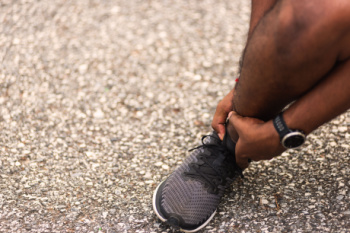
Heel pain often results from injury or everyday wear and tear. The pain can range from mild to severe, and it is frequently linked to conditions like plantar fasciitis, which occurs when the tissue connecting the heel to the toes becomes inflamed. Other causes include Achilles tendonitis, heel spurs, and bursitis, all of which can be caused by overuse, improper footwear, or repetitive activities. To alleviate heel pain, start by resting and elevating your foot to reduce inflammation. Stretch the calves and plantar fascia to help relieve tension. Wear supportive shoes with good arch support as well. If the heel pain persists beyond a few weeks, or worsens, it is suggested that you consult with a chiropodist who can provide a precise diagnosis and treatment options, which may include orthotics or corticosteroid injections. Seeking early treatment can prevent the pain from becoming chronic.
Heel pain is a common problem that can be caused by a variety of injuries, medical conditions, and other factors. If you suffer from heel pain, please consult with Emily Yu, B.Sc from Uptown Foot Care Clinic. Our specialist can help you maintain the health of your lower limbs and your mobility.
When it comes to heel pain, the exact location and type of pain are important to note. Some of the conditions that may cause heel pain include:
Plantar fasciitis - An inflammation of the ligament that runs along the bottom of the foot; it causes a stabbing pain under the heel that is at its worst when taking your first few steps after a long rest and while standing on your tiptoes or climbing stairs
Achilles tendonitis - An inflammation of the tendon in the back of the calf; it causes pain in the back of the heel that is at its worst after resting, as well as ankle and calf stiffness, swelling, and tenderness
Bone spurs - Bony lumps on the back of the heel bones that cause sharp pain upon first standing up; the pain becomes dull and achy over time
Heel fractures - A break or crack in the heel bone that causes pain, swelling, and difficulty walking
Retrocalcaneal bursitis - Swelling of the small, fluid-filled sac at the back of the heel bone; it causes pain, swelling, redness, and warmth in the back of the heel
Tarsal tunnel syndrome - Compression of the posterior tibial nerve which causes a pins and needles sensation in the heel, foot, and calf
Your chiropodist will be able to diagnose the underlying cause of your pain and prescribe the right treatments for you. If you have any questions, please feel free to contact our office located in . We offer the newest diagnostic and treatment technologies for all your foot care needs.
Risk Factors and Care Tips For Diabetic Feet
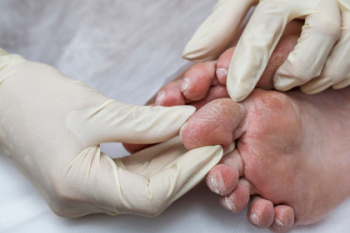
Diabetes can lead to serious foot problems due to poor circulation and nerve damage, both of which are common complications of the condition. High blood sugar levels can damage blood vessels, reducing blood flow to the feet and slowing down the healing process. Additionally, nerve damage, or diabetic neuropathy, can cause numbness, making it difficult to detect injuries or infections. Common foot problems for diabetics include ulcers, infections, and Charcot foot, a condition where bones in the foot weaken and collapse. Key risk factors for foot damage include uncontrolled blood sugar levels, smoking, and wearing poor footwear. To reduce risks, it is crucial for individuals with diabetes to inspect their feet daily for cuts or sores, keep their feet clean and dry, wear properly fitted shoes, and manage blood sugar levels effectively. If you have diabetes, it is strongly suggested that you are under the care of a chiropodist who can help you to manage this serious condition.
Diabetes can cause serious problems in the lower limbs if proper preventive measures are not taken and diabetic wound care is not performed. If you would like to learn more about caring for diabetic feet, please consult with Emily Yu, B.Sc from Uptown Foot Care Clinic. Our specialist can help you maintain the health of your lower limbs and your mobility.
Diabetes can lead to a host of foot and ankle complications, including:
Poor circulation
Peripheral neuropathy
Diabetic foot wounds and ulcers
Infection
Corns and calluses
Dry, cracked skin
Nail disorders
Hammertoes
Bunions
Charcot foot
If you have diabetes, you must be vigilant of any changes in your foot health. This is best done through daily foot inspections. Using a mirror to help you if necessary, look for any:
Cuts, scrapes, sores, or wounds
Bruising or discoloration
Swelling
Rash
Foul odor
Nail changes
Hair loss
Warmth and inflammation
Deformities
Lower limb pain
Strange sensations (numbness, tingling, burning, pins, and needles)
If you detect anything unusual, seek the care of a chiropodist as soon as possible. If you have any questions, please feel free to contact our office located in . We offer the newest diagnostic and treatment technologies for all your foot care needs.
